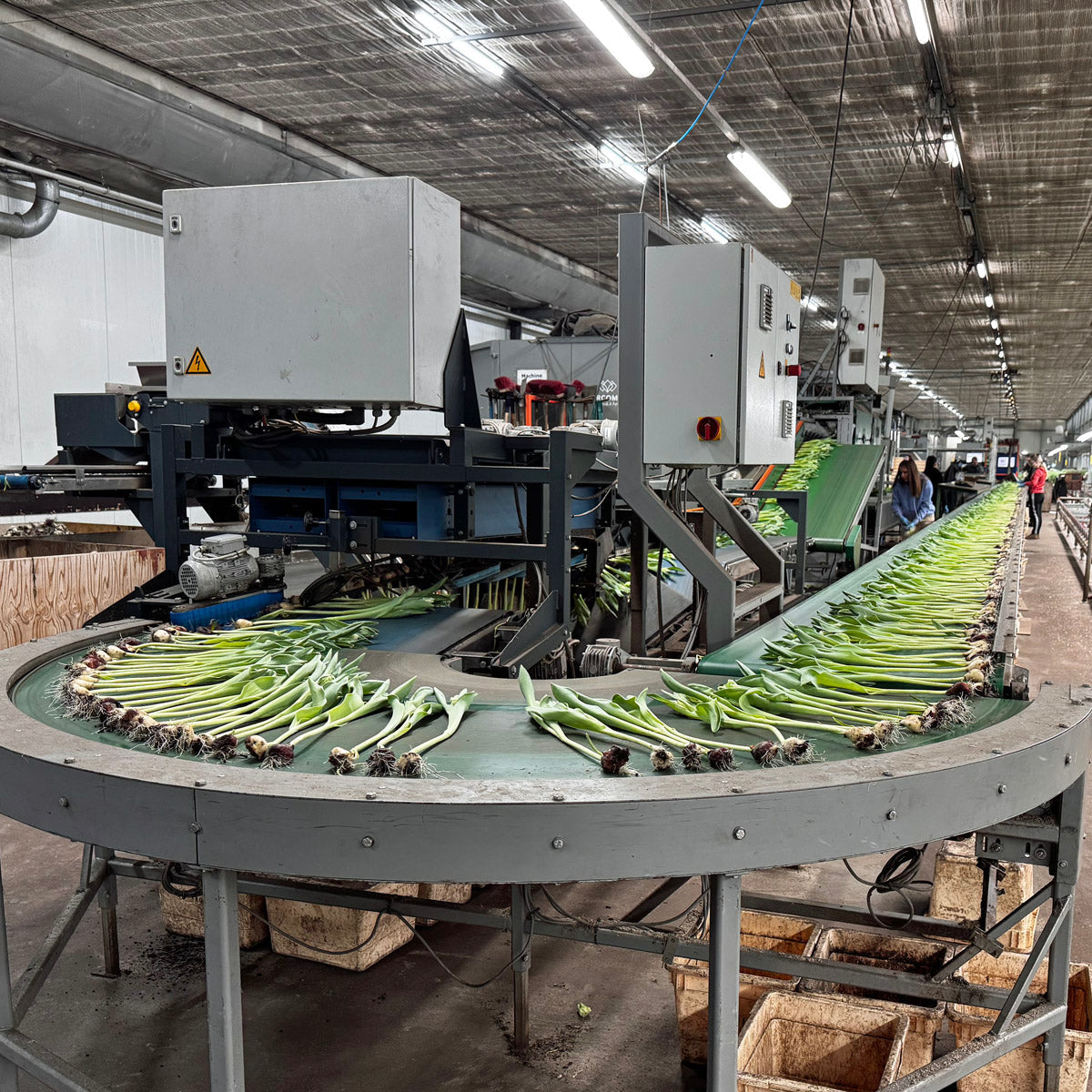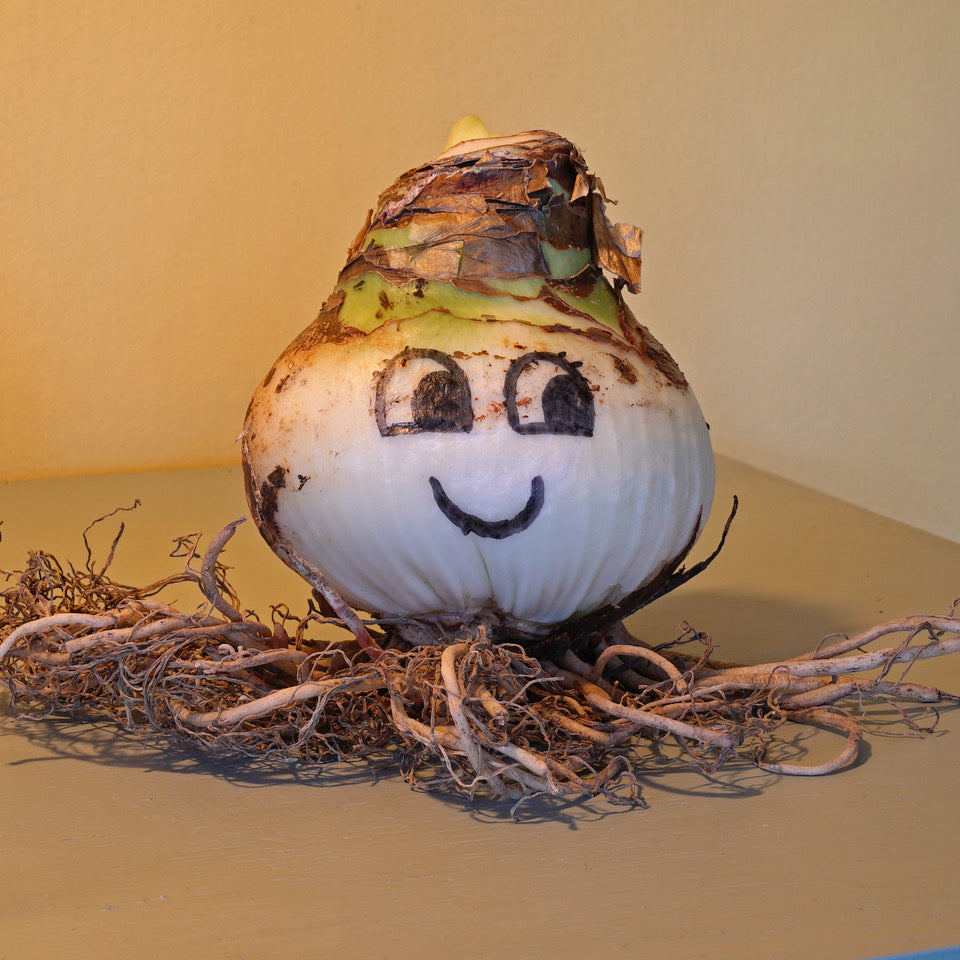The First Rule of Beet Club
 Before I start talking about bulbs again, it is time for a little trip down memory lane. It’s a bit of a long forgotten fact about me, but at one point in my life, I was the World Champion Beet Grower of the area. Are there World Champion Beet Growers, you may ask yourself, and I can tell you that yes, there are. For over fifty years, a group of agricultural growers and farmers from the area has hosted a competition to find out who can grow the heaviest beet. It sounds like a playful affair, but don’t be fooled: it is a serious race, organised by the club “De Dorstige Biet,” literally translated “The Thirsty Beet,” with over five hundred competitors every year. And every single one of them has their very own, very secret strategies to win the title. The first rule of Beet Club? Keep your friends close, and your beet closer.
Before I start talking about bulbs again, it is time for a little trip down memory lane. It’s a bit of a long forgotten fact about me, but at one point in my life, I was the World Champion Beet Grower of the area. Are there World Champion Beet Growers, you may ask yourself, and I can tell you that yes, there are. For over fifty years, a group of agricultural growers and farmers from the area has hosted a competition to find out who can grow the heaviest beet. It sounds like a playful affair, but don’t be fooled: it is a serious race, organised by the club “De Dorstige Biet,” literally translated “The Thirsty Beet,” with over five hundred competitors every year. And every single one of them has their very own, very secret strategies to win the title. The first rule of Beet Club? Keep your friends close, and your beet closer.
Where the beet is planted, in what kind of soil, what kind of animal excrement is fed to it, spraying it with nettle tea, seaweed extract… nothing is too crazy for this particular game. The people in it do their very best to get to know their beet and to find out what it wants in order to become as large as possible.
I’m not a professional beet grower (though I’d like to be). The year in which I won, 1988, was a bit of a stroke of luck. I didn’t know the first thing about beets, and entered the competition mostly for the party afterwards. That party is legendary: to end the competition, there is a “Beet Ball,” (Dutch: “Bietenbal”), where the champion is revealed and celebrated, and where the ‘Thirsty’ part of the club’s name is being honored by all its members. The summer of 1988 was cold and wet, and I had planted my precious beet seeds at different places around the house where I lived with my parents. One of those places was my father’s tiny greenhouse, where he and I used to grow his Daffodils for the local show De Lentetuin. That turned out to be the only seed that went somewhere, and because of that, we focused all our attention on it. We gave it goat poop, fertilizer, everything it could possibly want. The beet got to 27,7 kilograms, and I earned ever-lasting fame. The national anthem was played, I received a trophy, and, most importantly, a kiss from ‘Miss Beet 1988’.  Beet seeds
Beet seeds
This year, I suddenly felt the urge to try and defend my championship title. Not even just to go to the Beet Ball, although, let’s be honest, I do want to go, but also because I want to see if I can create a beet this large again. When I won in 1988, the record was set at 32 kilos, but it has improved insanely over the years: now, the record is set at an astounding 71 kilos, and there is almost never a podium place for people that have beets under 50 kilos. A beet as heavy as myself is what I need.
So I went to Waarland, where Kees Stoop, Beet Mastermind and an important member of the club, gave me a bag of beet seeds from Bejo Zaden for 10 euros. I also got a cup of coffee, and to finally catch up with him again–a good start.  Don’t tell anyone, but I think I’ll do well this year. The secret to a good beet can be found in astrology, especially the Chinese version, I think, because I planted my beet seeds last Wednesday, on the first full moon of the Chinese Year of the Snake. I put my seeds in empty loo rolls, so I can move them around easily. Again, don’t tell anyone, but I think the secret is going to be that the year will be dry, desert-dry, and I’ll use the loo rolls to plant my beets in soil directly connected to the garden hose (in Dutch called a Garden Snake, a good astrological sign if I’ve ever seen one). Probably no one else has thought of it. I will have the most obeetsitas beet, and my championship will be defended.
Don’t tell anyone, but I think I’ll do well this year. The secret to a good beet can be found in astrology, especially the Chinese version, I think, because I planted my beet seeds last Wednesday, on the first full moon of the Chinese Year of the Snake. I put my seeds in empty loo rolls, so I can move them around easily. Again, don’t tell anyone, but I think the secret is going to be that the year will be dry, desert-dry, and I’ll use the loo rolls to plant my beets in soil directly connected to the garden hose (in Dutch called a Garden Snake, a good astrological sign if I’ve ever seen one). Probably no one else has thought of it. I will have the most obeetsitas beet, and my championship will be defended.
You can probably guess right about now that most of our Thirsty Beet Club’s members have stories like these. If you meet one of them, I recommend asking, they will love you forever if you give them a reason to tell it to someone. But enough about the beets: I had promised you last week to talk a little bit about the Daffodils in my greenhouse. If you are still curious about The Thirsty Beet, be sure to check out www.dedorstigebiet.nl, you can find everything you need to know on their website. The rule is that the beets need to be grown above the Bergen-Alkmaar-Hoorn-geographical line, in order to make sure that all competing beets were grown in roughly the same environment, but other than that, literally everyone can enter–it is, after all, a World Championship. So if you have a location in the neighbourhood, come join us! My greenhouse is overflowing: there are 656 pots filled with Daffodils. Every pot is a different variety, so I’ll get to see over six hundred different Daffodils over the next few weeks. Over half of those are seedlings, so they do not yet have a name and are still in the process of being selected for further growing. Usually, I want to see how they do outside, but we’ve had a few bad years: Last year, a bad downpour of hail ruined almost all of the Daffodil’s petals, and the year before that, a strong wind from the North Sea did the same thing. In my greenhouse, Mother Nature has slightly less influence on my poor, delicate Daffodils, so they are safely kept inside this year.
My greenhouse is overflowing: there are 656 pots filled with Daffodils. Every pot is a different variety, so I’ll get to see over six hundred different Daffodils over the next few weeks. Over half of those are seedlings, so they do not yet have a name and are still in the process of being selected for further growing. Usually, I want to see how they do outside, but we’ve had a few bad years: Last year, a bad downpour of hail ruined almost all of the Daffodil’s petals, and the year before that, a strong wind from the North Sea did the same thing. In my greenhouse, Mother Nature has slightly less influence on my poor, delicate Daffodils, so they are safely kept inside this year.  This also makes taking photographs remarkably easier: better lighting, and the flowers are not on the ground, which makes getting a decent angle easier as well, that kind of stuff. They’ve been in the greenhouse for two weeks, and the first varieties are starting to show themselves a little bit. Not all of them are seedlings: Some varieties are here because I want new, better photos of them.
This also makes taking photographs remarkably easier: better lighting, and the flowers are not on the ground, which makes getting a decent angle easier as well, that kind of stuff. They’ve been in the greenhouse for two weeks, and the first varieties are starting to show themselves a little bit. Not all of them are seedlings: Some varieties are here because I want new, better photos of them.  There are some really promising new varieties coming out of the seedlings, and this is one of them: A miniature Daffodil with elegant flowers, who also tries her very best to bloom alongside the snowdrops early in the year. This one if for sure a keeper for now, if she keeps on growing, and her bulbs are healthy as well, we might need a name for her soon.
There are some really promising new varieties coming out of the seedlings, and this is one of them: A miniature Daffodil with elegant flowers, who also tries her very best to bloom alongside the snowdrops early in the year. This one if for sure a keeper for now, if she keeps on growing, and her bulbs are healthy as well, we might need a name for her soon.  Dahlia Lizz Baaij
Dahlia Lizz Baaij
I’m almost at 1000 words, and there is still an announcement to be made: Today is the last day to order Amaryllises. The number of varieties left in stock isn’t huge, but as usual, there are some left over that truly surprise me by not being sold out yet. And, if you buy one, you get an extra Amaryllis, too: You can read the story about that in the blogs of last week and two weeks ago. And, if you’re in our shop anyway: Our Dahlia assortment is still at her most beautiful. One variety has sold out already, so if you are in love with a particular one, I urge you to consider getting it: She might be gone before you know it, and it would be a shame to miss out on a favourite. There are over a hundred varieties, more than twenty of which are new introductions to our assortment–please, shop your heart out. Next week, I’ll tell you more about the Dahlias.
Kind regards,
Carlos van der Veek
























 Deutsch
Deutsch English
English Nederlands
Nederlands
